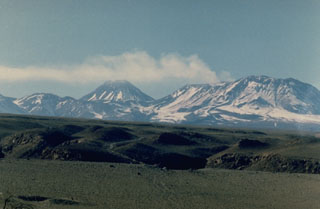Report on Lascar (Chile) — June 2000
Bulletin of the Global Volcanism Network, vol. 25, no. 6 (June 2000)
Managing Editor: Richard Wunderman.
Lascar (Chile) Ash eruption on 20-21 July
Please cite this report as:
Global Volcanism Program, 2000. Report on Lascar (Chile) (Wunderman, R., ed.). Bulletin of the Global Volcanism Network, 25:6. Smithsonian Institution. https://doi.org/10.5479/si.GVP.BGVN200006-355100
Lascar
Chile
23.37°S, 67.73°W; summit elev. 5592 m
All times are local (unless otherwise noted)
At about 1044 on 20 July 2000, an eruption began at Lascar volcano that lasted until 1509. The Washington VAAC reported an ash advisory at 1509 for an ash plume that extended 660 km to the E, stretching from N Chile across S Bolivia and N Argentina and into W central Paraguay. At that time, the plume was traveling at speeds of up to 130 km/hour, reached altitudes of 10.7-13.7 km, and was reported to be 103 km wide.
Residents of the village of Jama, located 60 km ENE of the volcano on the Argentina-Chile border, reported feeling an earthquake before seeing a white mushroom cloud that rose 4-5 km high and rapidly blew E, depositing 1-2 mm of ash over the village. Several explosions were felt and heard 160 km ESE in San Antonio de los Cobres, but there were no reports of any injuries or damage. Activity continued into 21 July with small explosions producing plumes 200-300 m above the summit. The volcano is in a sparsely populated area so no evacuations were necessary.
According to Matthews and others (1997) Lascar has undergone four recognized cycles between 1984 and 1993. In each of these cycles, a lava dome is extruded in the active crater accompanied by vigorous degassing through high-temperature, high-velocity fumaroles on and around the dome. The dome then subsides into the conduit while the velocity and gas output of the fumaroles decrease; the cycle ends with violent explosive activity. No new lava was immediately extruded after the dome collapsed in the explosive 1993 eruption, thus breaking the previous pattern.
Background. Lascar is the most active volcano of the northern Chilean Andes; it is characterized by its persistent fumarolic activity, steam eruptions, and occasional vulcanian eruptions. The andesitic-to-dacitic stratovolcano contains six overlapping summit craters along a NE-SW trend.
Matthews and others (1997) discussed Lascar's evolution in four phases starting at ~50 ka. During phase I, an edifice was established on the E side, and pyroxene andesite lavas erupted. Phase II saw the development of the W edifice with a subglacial andesitic eruption, and the destruction of a substantial dome, arguably the volcano's most explosive event. In Phase III, a stratocone was constructed and a major andesitic explosive eruption generated scoria flows, known as the Tumbres deposits, dated at 9.2 ka. Phase IV activity shifted back to the E, leaving pyroclastic deposits dated at 7.1 ka. Prominent Phase IV lava flows extended NW and were later truncated by the formation of three deep collapse craters that mark the W migration of the active center. The current active vent discharges in the deepest of these craters, which is 800 m in diameter and 300 m deep. Frequent explosive eruptions have been recorded since the mid-19th century.
Reference. Matthews, S.J., Gardeweg, M.C., and Sparks, R.S.J., 1997, The 1894 to 1996 cyclic activity of Lascar Volcano, northern Chile: cycles of dome growth, dome subsidence, degassing and explosive eruptions: Bulletin of Volcanology, v. 59, p. 72-82.
Geological Summary. Láscar is the most active volcano of the northern Chilean Andes. The andesitic-to-dacitic stratovolcano contains six overlapping summit craters. Prominent lava flows descend its NW flanks. An older, higher stratovolcano 5 km E, Volcán Aguas Calientes, displays a well-developed summit crater and a probable Holocene lava flow near its summit (de Silva and Francis, 1991). Láscar consists of two major edifices; activity began at the eastern volcano and then shifted to the western cone. The largest eruption took place about 26,500 years ago, and following the eruption of the Tumbres scoria flow about 9000 years ago, activity shifted back to the eastern edifice, where three overlapping craters were formed. Frequent small-to-moderate explosive eruptions have been recorded since the mid-19th century, along with periodic larger eruptions that produced ashfall hundreds of kilometers away. The largest historical eruption took place in 1993, producing pyroclastic flows to 8.5 km NW of the summit and ashfall in Buenos Aires.
Information Contacts: José Viramonte, Universidad Nacional de Salta and CONICET, Buenos Aires 177 -4400 Salta, Argentina; George Stephens, NOAA Operational Significant Events Imagery Support Team, World Weather Bldg., 5200 Auth Road, Rm. 510, NOAA/NESDIS, Camp Springs, MD 20748 (URL: https://www.nnvl.noaa.gov/); Associated Press.

